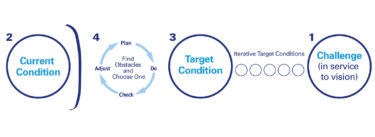One of the best things about leading the Lean Enterprise Institute is that I travel widely to learn how things are going across the Lean Community. Recently I’ve looked at two truly interesting operations, one in New Hampshire, USA, and the other outside of Chennai, India. Together they provide an important lesson about lean transformations.
In New Hampshire I visited Freudenberg-NOK’s Manchester molding operation, which I have seen a number of times over the years. This facility started its lean transformation at the beginning of the 1990s with kaizen breakthrough projects under the GROWTTH (Get Rid of Waste Through Team Harmony) program to cellularize operations and then introduced smooth flow of product families through the facility. Doing this highlighted the problems with product and machine design and led to a 3P initiative to get the next generation of product and process technology right. And recently, the Manchester facility has gotten serious about Six Sigma, getting scrap down to .7% (and even lower on some processes) from around 7% overall at the beginning of the 1990s. Note that the sequence for the lean transformation was kaizen (TPS), 3P, and Six Sigma.
This summer in India I visited a remarkable air brakes plant belonging to the TVS Group that is one of the leanest operations I have ever seen outside of Toyota City. TVS started their journey in the late 1980s with TQM and by 1996 their brake plant became the first outside of Japan to win the Deming Prize. (A second TVS plant making brake linings won the Deming Prize this year.) They then worked very hard at TPM to make every machine available when needed to make good parts. And in the last four years, with aid from my friend Tom Luyster, they have cellularized all of their operations, introduced standard work for everyone, inaugurated periodic materials movements with tugger routes, and initiated a pure pull system all the way through their large plant and back to all of their suppliers. Note that the sequence was TQM, TPM, and TPS in a reverse order from the Manchester transformation.
My conclusion is that all of us making a lean leap will need to deal with capability issues (TQM/Six Sigma) and with availability issues (TPM) while removing wasted steps and introducing flow and pull in every value stream (TPS). My further conclusion is that there is no “right sequence” to follow in tackling these problems. Rather it depends on the nature of the product, the nature of the process technology, and the nature of the business.
Where there is a “right” versus a “wrong” is with leadership and management. Each of these successes was undertaken at the urging of a strong change agent – Joe Day at Freudenberg-NOK and Mak Mahesh at the TVS group – and both firms focused on getting everything right for entire product families running all the way through the company, by means of strong value stream management.
Given the importance of these conclusions, I’m devoting my keynote talk to them at the Association for Manufacturing Excellence in Chicago. My title will be “In Search of the Perfect Process.” Because it’s only three weeks until Chicago, I hope you have made your plans to be there. If not, you can easily register by going to www.ame.org.






